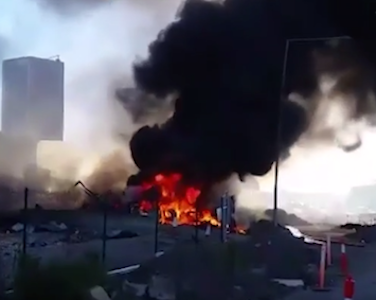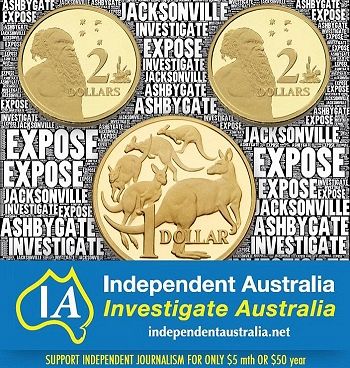The horrific accident in which five people died when a plane crashed at Essendon's DFO shopping centre will likely lead to safer flying procedures, but hazardous overdevelopment near runways is unlikely to be addressed, writes Dr Norm Sanders.
Facts
ON THE MORNING of 20 February 2017, five men boarded a Super King Air 200 turboprop aeroplane at Essendon Airport in Melbourne, for a flight to King Island across Bass Strait.
The pilot was veteran airman Max Quartermain, with many years of experience. He had held a CASA Air Operations Certificate for more than 38 years, and ran a firm called Corporate and Leisure Travel, which operated the flight.
Just after the crash, The Australian carried a story with the headline, 'Plane crash Melbourne: Pilot was under investigation over near miss'.
In fact, the two planes were two kilometres apart and the problem was found to be faulty GPS navigation equipment. Quartermain had passed two proficiency checks since.
The passengers, all Americans, were Greg DeHaven, Glenn Garland, Russell Munsch and John Washburn. Keen golfers, they were on a three-week dream holiday and were heading for King Island to sample the course. This is about half the load the Super King Air is capable of carrying. However, the plane was carrying a full load of fuel.
Melbourne’s worst aviation disaster in 30 years: Plane crash claims the lives of five people. @NickMcCallum7 #7News https://t.co/wmz73BmAvQ
— 7 News Melbourne (@7NewsMelbourne) February 21, 2017
The aeroplane (with the registration VH-ZCR) was one of the world's most popular turboprop twin-engine aircraft. Over 3,550 King Airs have been built. They are the mainstay of the Royal Flying Doctor Service, and are used extensively by air forces and tourist operators all over the world. This particular aircraft had been based in Noumea for a period.
They are powered by Pratt and Whitney Canada PT6 turboprop engines – basically, a jet engine harnessed to a propeller – and are known for reliability with an in-flight shutdown rate of one per 333,000 hours since 1963. Over 51,000 have been built. This particular aircraft had been through an engine and airframe maintenance check a few weeks before.
With all on board and luggage stowed, Quartermain obtained a taxi clearance from the Essendon Airport Control Tower and taxied to runway 17. Runways are numbered by their magnetic headings. Runway 17 is 170 degrees, or almost due south — the direction of King Island. Runway 17 is the shortest of Essendon's two runways, at 1,504 metres. Runway 26, by comparison, is 1,921 metres. Runway 17's 1,500 metres is more than ample for a lightly loaded Super King Air.
The tower cleared the aircraft for takeoff at 8.59 am. Seconds later, Quartermain gave a mayday call. Witness saw the aircraft leave the ground and veer left before striking the roof of the DFO Homemaker Centre, and crashing in a ball of burning fuel.
The DFO complex is actually within the airport boundary and is close to the edge of Runway 17. Putting a large shopping complex right next to an active runway is an example of atrocious planning and avarice. Airports are originally sited on the outskirts of cities, where there is flat land surrounded by empty paddocks. This type of land is as attractive to developers as dead meat is to flies.
The most dangerous time of any flight is the moment just before or immediately after takeoff. Open land near the runway is the best insurance against injury or death. Paddocks where an aircraft overshooting the runway would previously only scare some sheep, eventually get covered with businesses and houses whose occupants complain about the noise and petition for airport closure.
Essendon Airport is a perfect example.
It started with a few biplanes on a grass runway 13 kilometres from the CBD in the 1920s. Sir Charles Kingsford Smith landed there several times. The airport kept expanding and, during WWII, was used by U.S. B-24 bombers. In 1950, Essendon became one of two international airports in Australia. The Beatles disembarked there, as did U.S. President Lyndon Johnson. When Tullamarine Airport opened in 1970, Essendon became a base for cargo, regional airlines, executive jets and charter operations.
The recent crash has reignited the call for the airport to be closed, which has the developers salivating.
Conjecture
Most crashes occur in remote areas, which make determining causes difficult. The Essendon crash is unusual in that many witnesses watched the entire tragedy as it happened. Some even took videos. (They showed a clear blue sky. The weather was not a problem.) Tower personnel, pilots – including those with King Air experience – and motorists, all watched the disaster unfold. The Australian aviation community is trying to come to grips with the crash and understand what went wrong.
The situation was discussed on pilot forums, like Professional Pilots Rumor Network (PPRuNe). Apparently, the first part of the flight was uneventful. The King Air accelerated down the runway until reaching "V1" — V1 is the speed by which a pilot must have decided to abort if they are going to stop on the runway. It depends on runway length, obstacles, temperature, runway slope and the weight of the aeroplane. In a two-pilot airliner cockpit, one pilot will be at the controls and the other will be watching the airspeed. V1 will be closely followed by “rotate” and the airliner will climb into the air.
For the Super King Air, V1 is 74 knots or 137 kph. After V1, the pilot is committed to continuing the takeoff. This is a very critical point.
Victoria Police Assistant Commissioner Stephen Leane was quoted in Australian Aviation as saying:
“A charter plane, a twin-engine plane left the Essendon Airport and shortly after takeoff had a catastrophic engine failure.”
In planes like a King Air, losing one engine requires instant action by the pilot. The good engine has enough power to continue the takeoff (at a much-reduced rate of climb) but the thrust on one side means the plane will turn towards the "dead" engine with its windmilling propeller. The pilot has to quickly correct with the rudder in the direction away from the failed engine and must never turn towards the side it is on. The mantra is "dead engine, dead foot" (on the rudder pedal).
That the King Air veered to the left may indicate that the plane's left engine was the one which had failed. Along with quick rudder action, the dead engine's propeller must be "feathered". In normal operation, the propeller has a fairly flat pitch. This can cause massive drag if the blades aren't quickly turned to "feather" into the wind. Some light twins must be feathered by the pilot, but the Super King Air has an automatic feathering system which operates during an engine failure. As if all this isn't enough, the pilot also has to retract the landing gear to reduce drag.
Modern twin-engined jet airliners have so much power that losing an engine after V1 is much less of a problem than in a smaller twin. In addition, there is no propeller to feather and all the immediate action that is required is to lessen the angle of the climb by a few degrees. There is another theory about why Quartermain veered to the left. He may have suffered engine problems and chose not to land straight ahead into houses but to try for the inbound lanes of the Tullamarine Freeway just past the DFO.
Essendon plane crash: Aviation experts warn of dangers of building shops on airport land https://t.co/Bn54lqPc00 via https://t.co/80pjNM0MFw
— PAIN_NET (@PAIN_NET1) March 13, 2017
Some of the many questions are:
- What was the nature of the "catastrophic engine failure"?
- Did Quartermain rush the takeoff and leave the ground at too low a speed for a single engine climb after an engine failure?
- Did he suffer a heart attack?
- Why did he send a mayday call just after takeoff, when he was so busy dealing with the situation? (Normally, the mayday call would be made after the aircraft was airborne and stable. The controllers would then clear traffic for a return to the airport.)
Quartermain gave no indication of what the problem was. There is a saying in aviation: "Aviate, Navigate, Communicate" — which means concentrate on flying the aeroplane first. Could he have successfully dealt with one problem, called “mayday” and then been confronted with another?
The answers will have to wait until the Air Transport Safety Bureau (ATSB) completes its investigation. The black boxes which record the flight have already been found and sent to Canberra for analysis. The four-man investigation team completed their work on Friday, 24 February. They located many components, including the engines and propellers, for detailed analysis. The ATSB also conducted a number of interviews with witnesses and obtained videos for further review.
When the ATSB publishes its report, lessons learned from the crash will be incorporated into procedures to make flying safer. Unfortunately, it is unlikely anything will be done about the DFO's dangerous location.
Dr Norm Sanders is a former Tasmanian MP and Australian Federal senator. He is also a qualified commercial pilot and flight Instructor.

This work is licensed under a Creative Commons Attribution-NonCommercial-NoDerivs 3.0 Australia License
Monthly Donation
Single Donation
Get the facts. Subscribe to IA for just $5.











